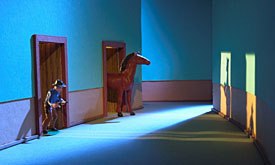Panique au Village "The Cake" caused a riot of laughter at Annecy 2001 where it won for best TV program. Now this certifiably crazy show is coming to television. Philippe Moins reports on the insanity.

The visual simplicity of Panique au village is deceptive. The series becomes more sophisticated as it evolves. © La Parti Productions.
Early morning. Cowboy, Indian, Horse, Farmer, Robin and Constable are ready for new adventures. Imagine lots of little plastic figurines just like the ones we all used to play with as kids. Imagine two animators using them in a knowingly child-like way to tell us about these crazy adventures.
A Picture of Insanity
Panique au village, a Belgian TV series, set for broadcast on Canal+ France at the end of the year and in Belgium shortly afterwards, will provide a welcome and humorous shot in the arm to the usually "well-behaved" world of model animation. It's being made and is set in Brussels, in a stop-motion animation studio, Studio Pic Pic André, located in an old, middle-class style house, near the gare du Nord with a small team of a dozen or so people working on three different sets. The pressure is on, since the series of 20 x 5 minute episodes must be completed for air at the beginning of 2003.

Stéphane Aubier (left) and Vincent Patar, co-creators and chief animators of Panique au village, started the project by purchasing toys from a flea market. © Philippe Moins.
However, the rapid work pace isn't down to deadlines, it's integral to the animation style of Vincent Patar and Stéphane Aubier, co-creators and chief animators on the project. How do you animate ready-made characters, picked up in flea-markets and for whom there are only two or three key poses? The way Patar and Aubier animate looks like kids moving their little toy soldiers around. But they also have a few tricks up their sleeve, sometimes inventing poses which don't exist, changing their characters' physique. For the audience, this unconcealed DIY approach adds to the viewing pleasure, although the cavalcade of absurd gags and crazy storylines prevent us from being overly distracted by the whys and wherefores. The set design owes something to that of electric train sets but also to the school handicrafts class, all in a very playful style. But make no mistake, as the series progresses, it gets more sophisticated, whilst retaining this apparent ingenuity which fits the style of the characters; they are also enhanced by fine lighting, not to make them look better or cuter, but because to make the series work the world it creates must be coherent and believable. There's little in the way of dialogue, apart from the odd intervention from the creators themselves, and from some of their long-term colleagues: Bruce Ellison, Fred Jannin, Bouli, Christian Hecq and Benoît Poelvoorde (whose credits include C'est arrivé près de chez vous, Le Boulet, Le vélo de Ghislain Lambert and others).

The fun and playful set is reminiscent of toy trains and school handicrafts class. © Philippe Moins.

A little Chuck Jones and Tex Avery, mixed with some Belgain absurdity, make Panique au village fresh and inventive. © La Parti Productions.
Finally, the series is scored by Bernard Plouvier, who has composed the music for many of Patar and Aubier's films; the title sequence varies slightly from one episode to another, with the French DJ Chazam playing variations on the initial theme tune to match.
Journey Into "3D"
Although their previous films were drawn animations, they also worked in much the same way: the three short films in the "Pic Pic André Shoow" (sic) were really delirious cartoons. They owed more to Chuck Jones and Tex Avery than Raoul Servais, but still had that typically Belgian yet hard-to-pin-down sense of the absurd.
With their move into "3D," Stéphane Aubier and Vincent Patar have taken a laudable initiative to break new ground in terms of the imaginative universe they had already established; one which until now seemed inherently that of a closed 2D world. Anyone who thought that these two were irrevocably tied to the drawn cartoon will be astonished. Returning, almost by chance, to an early student work -- they both studied at La Cambre some ten or so years ago -- which came across more as a game than a finished film, they first made a pilot called Panique à la cuisine. This generated a lot of enthusiasm, to the extent that producers Vincent Tavier and Philippe Kauffmann (La Parti) convinced the Communauté française de Belgique and Promimage to finance the project: 20 X 5 minutes, a relatively unusual format, but one, which was apparently what Canal+ France, who pre-bought the series, wanted.
Made for 900,000 Euros over 14 months by 9 people including the two creators, this deceptively simple series required some new thinking, mainly due to the technical demands of filming digitally, a relatively new technique; digital cameras were used for the shoot, and then the footage was reworked using After Effects.
Philippe Moins is a writer and teacher, and also the co-director of Anima 2003.







